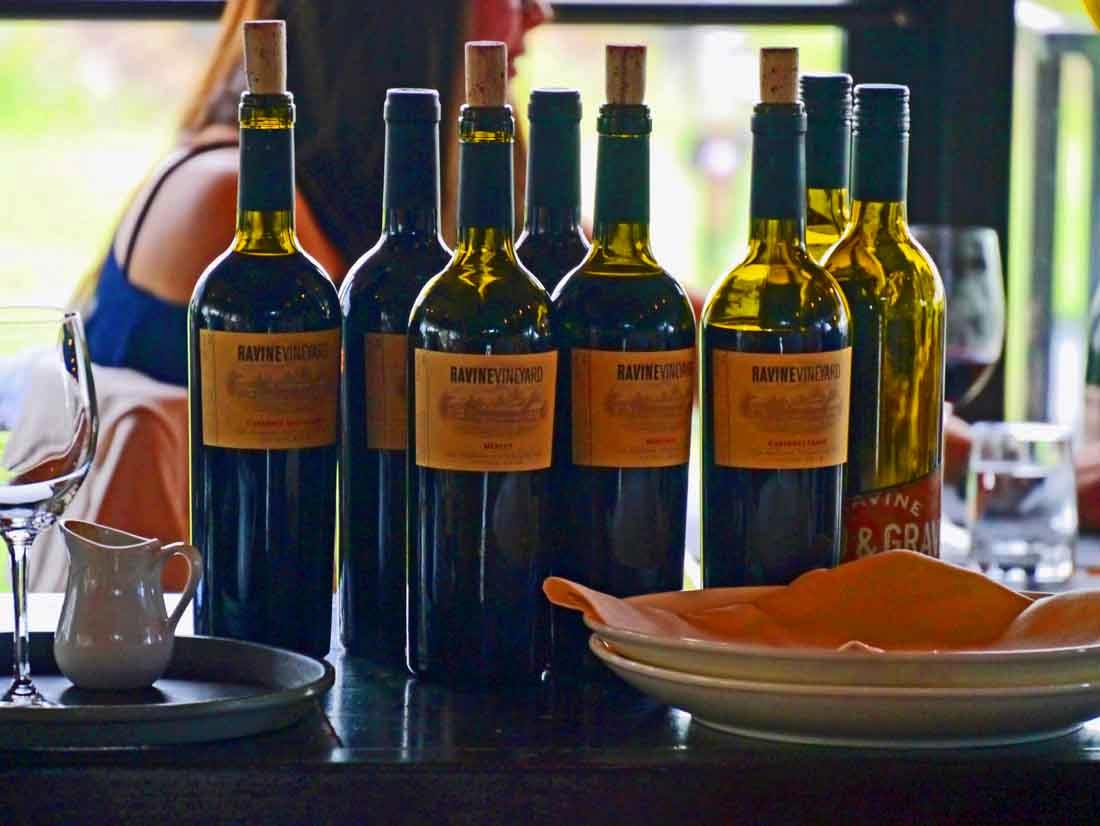 Norma Jean Lowery Harber’s family has farmed the 34 acres of Ravine Vineyard Estate (ravinevineyard.com) in St. Davids since 1867. Indeed, her great-grandfather planted the Niagara region’s first commercial vineyard here in 1869 and the land was in orchards for many decades. Norma Jean and her husband Blair Harber bought the farm from the rest of the family in 2004. They set about creating organic vineyards and an organic winery. Norma Jean’s father had grown wine grapes, and the couple replanted vineyards to focus on the three classic Bordeaux reds (Merlot, Cabernet Sauvignon, and Cabernet Franc) along with Chardonnay, Riesling, and small amounts of Gewürtztraminer.
Norma Jean Lowery Harber’s family has farmed the 34 acres of Ravine Vineyard Estate (ravinevineyard.com) in St. Davids since 1867. Indeed, her great-grandfather planted the Niagara region’s first commercial vineyard here in 1869 and the land was in orchards for many decades. Norma Jean and her husband Blair Harber bought the farm from the rest of the family in 2004. They set about creating organic vineyards and an organic winery. Norma Jean’s father had grown wine grapes, and the couple replanted vineyards to focus on the three classic Bordeaux reds (Merlot, Cabernet Sauvignon, and Cabernet Franc) along with Chardonnay, Riesling, and small amounts of Gewürtztraminer.
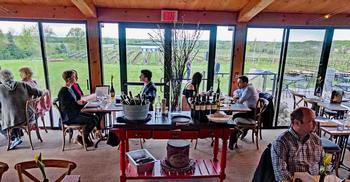 The wines are reason enough reason to visit Ravine. As luck had it, we missed the tasting room hours. But we had dinner in the farm restaurant looking out on the kitchen garden and down to some of the vineyards. And, naturally, we drank Ravine wines with dinner. The Harbers practice biodynamic principles in their restaurant gardens as well as in their vineyards. The restaurant focuses on highly local products—including the Berkshire hogs raised on the farm. A smokehouse on the property allows executive chef Ross Midgley to feature dishes with cured pork. The chef also preserves local bounty to extend locavore dining into the less fecund seasons.
The wines are reason enough reason to visit Ravine. As luck had it, we missed the tasting room hours. But we had dinner in the farm restaurant looking out on the kitchen garden and down to some of the vineyards. And, naturally, we drank Ravine wines with dinner. The Harbers practice biodynamic principles in their restaurant gardens as well as in their vineyards. The restaurant focuses on highly local products—including the Berkshire hogs raised on the farm. A smokehouse on the property allows executive chef Ross Midgley to feature dishes with cured pork. The chef also preserves local bounty to extend locavore dining into the less fecund seasons.
Charcuterie and Merlot
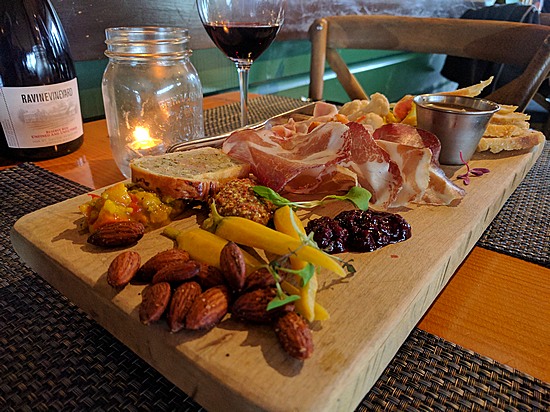 In fact, we started dinner with the chef’s charcuterie platter. The meaty anchors were honey ham, sliced coppa, and sausage—all cured downstairs in the charcuterie closet. A pot of heavenly chicken liver parfait was great for spreading on the country French baguette, and the pork country pâté en croute was just unctuous enough to benefit from the tangy pickled fennel and shallots and homemade coarse mustard.
In fact, we started dinner with the chef’s charcuterie platter. The meaty anchors were honey ham, sliced coppa, and sausage—all cured downstairs in the charcuterie closet. A pot of heavenly chicken liver parfait was great for spreading on the country French baguette, and the pork country pâté en croute was just unctuous enough to benefit from the tangy pickled fennel and shallots and homemade coarse mustard.
On our server’s recommendation, we drank Ravine Merlot with the dish. Merlot is the most round-heeled of the Bordeaux grapes, ripening to voluptuous fullness even in Niagara’s short season. Ravine’s version is soft and round, but it’s not sloppy. Nine months in French barrique disciplines the fruit.
Carrot soup and Riesling
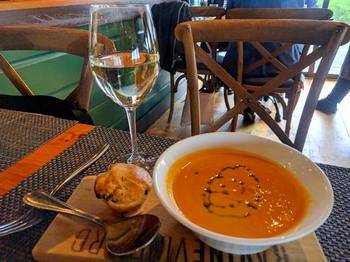 Ravine’s restaurant has a nice touch with its soup of the day. It serves each bowl with a savory sour cream and chive muffin. That was especially nice with a bowl of carrot-ginger soup topped with a drizzle of balsamic vinegar. The accompanying wine was the house Riesling. Like the Merlot, it is a fruit-forward wine with a good acidity that brings out the brightness of the grape. Characteristic of the Mosel clones, the aromatics are lightly floral.
Ravine’s restaurant has a nice touch with its soup of the day. It serves each bowl with a savory sour cream and chive muffin. That was especially nice with a bowl of carrot-ginger soup topped with a drizzle of balsamic vinegar. The accompanying wine was the house Riesling. Like the Merlot, it is a fruit-forward wine with a good acidity that brings out the brightness of the grape. Characteristic of the Mosel clones, the aromatics are lightly floral.
Scallop and pasta with Sauvignon Blanc
 Chef Midgley’s sense of food balance paired especially well with winemaker Martin Werner’s rendering of Sauvignon Blanc. The pasta of the day was a delightful tangle of homemade spaghetti with lovage and arugula, a butter sauce, and asparagus. Perched on top was a perfectly seared scallop. The range of textures and flavors in a small dish was striking.
Chef Midgley’s sense of food balance paired especially well with winemaker Martin Werner’s rendering of Sauvignon Blanc. The pasta of the day was a delightful tangle of homemade spaghetti with lovage and arugula, a butter sauce, and asparagus. Perched on top was a perfectly seared scallop. The range of textures and flavors in a small dish was striking.
The Sauvignon Blanc was even more striking. Werner treats it like Sancerre, fermenting with both wild yeast and a controlled inoculation, then barrel-aging on the lees. It has pronounced white grapefruit and lemon notes with a surprising creaminess. The crisp acidity cut through the butter sauce and highlighted the herbal notes of the vegetables in the dish.
Chardonnay for the main dishes
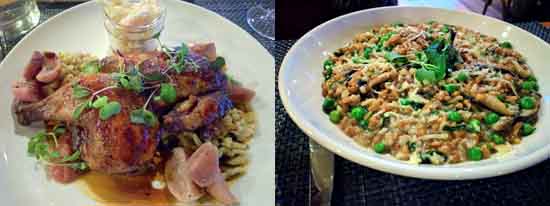 Ravine ages its standard Chardonnay in small barrels of an assertive French oak. That produces a French-inflected wine with distinctively New World fruit. It is creamy and lightly oaky, lush with the apple and pear notes characteristic of cold-climate Chard. Those properties make it a good all-purpose white to pair with food—much as the Ravine Merlot is a good all-purpose red. We had a brined and smoked heritage half-chicken and a mixed-grains “risotto” made with shiitake mushrooms and an Ontario gouda-style cheese. The Chardonnay’s oakiness was a nice complement to the smoke in the chicken, and its broad acidity counterbalanced the richness of the cheese in the “risotto,” which had intense cereal flavors of its own from the wheat berries and barley.
Ravine ages its standard Chardonnay in small barrels of an assertive French oak. That produces a French-inflected wine with distinctively New World fruit. It is creamy and lightly oaky, lush with the apple and pear notes characteristic of cold-climate Chard. Those properties make it a good all-purpose white to pair with food—much as the Ravine Merlot is a good all-purpose red. We had a brined and smoked heritage half-chicken and a mixed-grains “risotto” made with shiitake mushrooms and an Ontario gouda-style cheese. The Chardonnay’s oakiness was a nice complement to the smoke in the chicken, and its broad acidity counterbalanced the richness of the cheese in the “risotto,” which had intense cereal flavors of its own from the wheat berries and barley.
—
For an overview of Niagara wineries, see the web site of the Vintner’s Quality Alliance of Ontario (vqaontario.ca) or Visit Niagara (visitniagaracanada.com).
